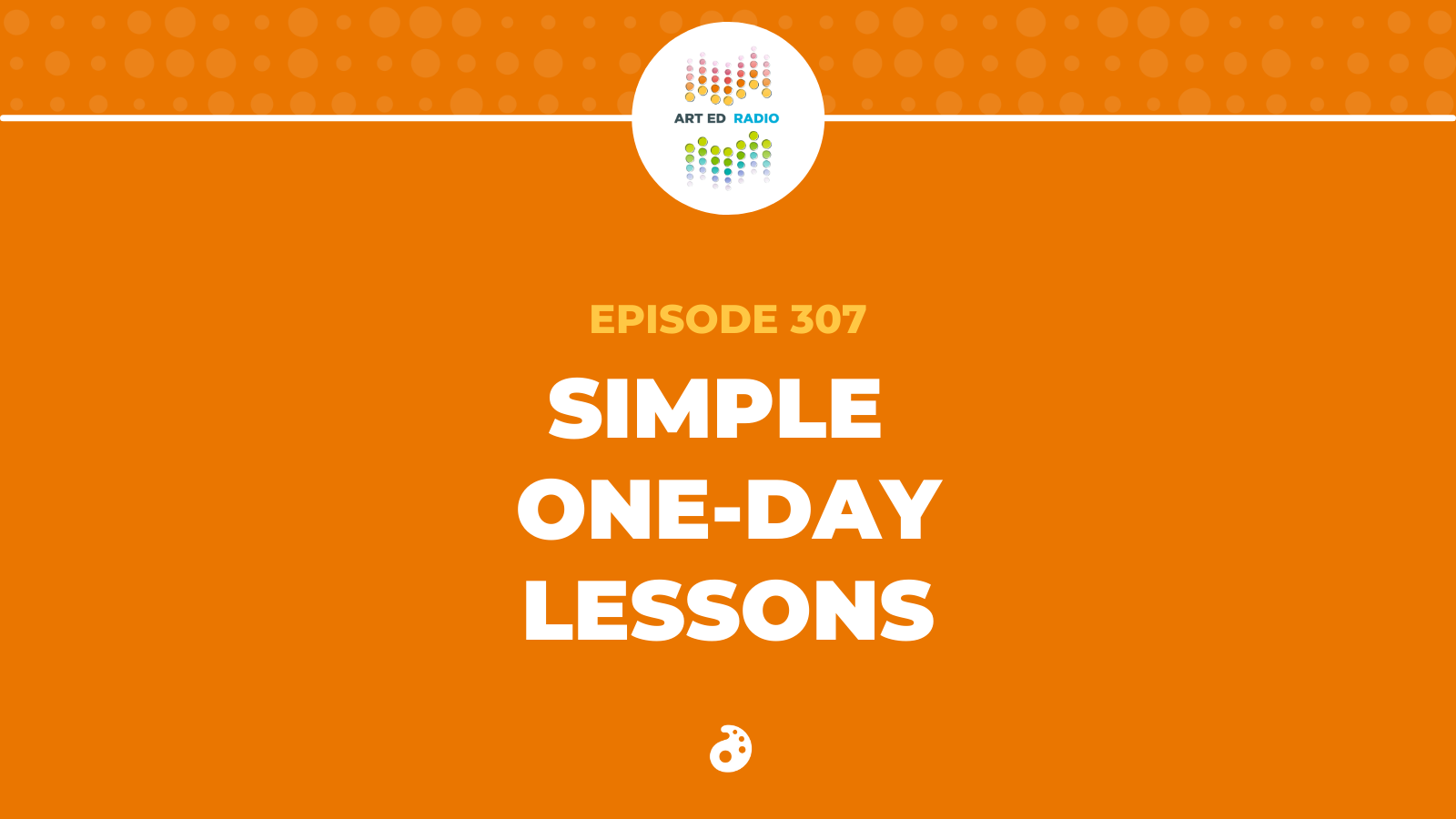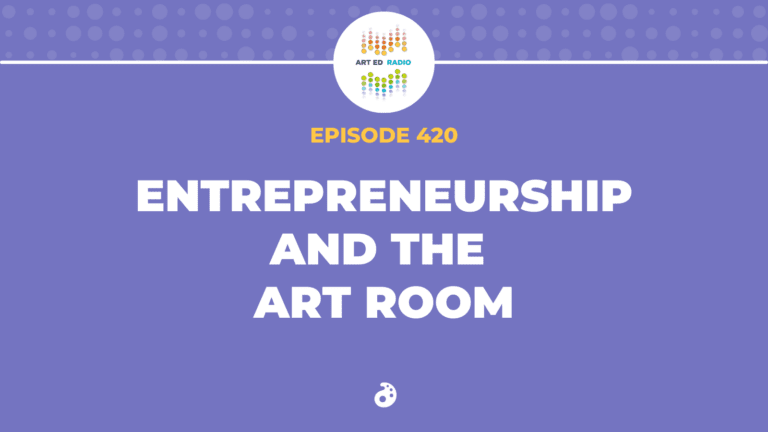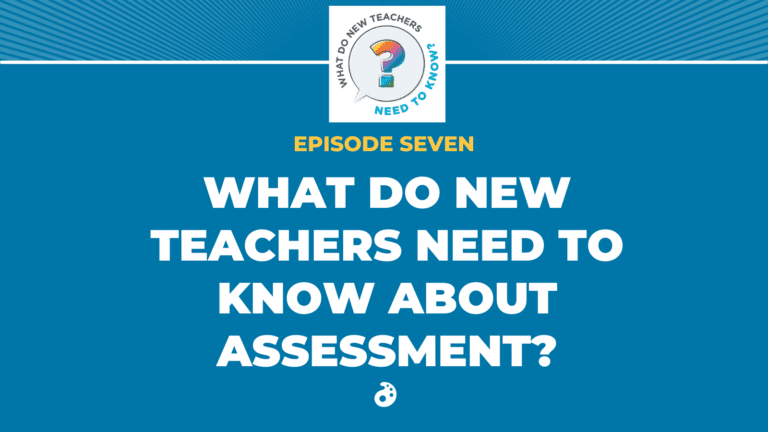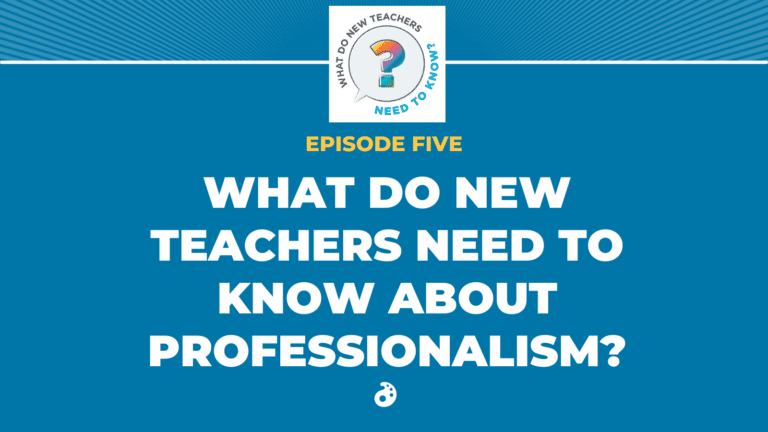Though we may be feeling optimistic that things will eventually be getting closer to normal in our classrooms, we still need to get through the rest of a difficult year. In today’s episode, Tim shares some ideas for simple one-day lessons that can fill the inevitable gaps when needed. Listen as he talks about how quick lessons can engage students, how you can make those lessons worthwhile, and why it’s okay to step back and take a breath every once in a while. Full Episode Transcript Below.
Resources and Links
- 7 Lessons For When You’re In A Pinch
- Read more about art challenges
- Jennifer Sell’s post on water droplets
- Check out the Creating Art Outside PRO Pack

Transcript
Tim: Welcome to Art Ed Radio, the podcast for art teachers. This show is produced by The Art of Education University. And I’m your host, Tim Bogatz.
Now, as we know, and as we’ve talked about for a long time, this year has been incredibly difficult for just about every teacher, the last couple of years have been. But, I feel like things are starting to shift. Maybe we’re starting to see summer break on the horizon. Maybe we can start thinking about the end of the year. I don’t know if everyone is there yet, but I do know that we can begin thinking about what it’s going to take to get us through the rest of this really difficult year. I want to talk a little bit more about that in the coming weeks, just kind of how everyone is feeling, how we’re going to manage getting through, and how we look at this summer as far as rest goes, and how we look at this summer as far as resetting for the next school year. I want to talk about all of that in the coming weeks, what our approaches are going to be, and what teachers need to get through all of this and reset and come back strong next year.
But today, I want to talk about some lessons and some ideas that might help you get through some of your more difficult days. Because as much as we may want to look forward, as much as we may want to think about how we’re going to rest this summer and how possibly we can get back to you a more normal approach next year, we still have to make it through what we’re facing right now. And let’s face it, there’s still a lot of difficult days.
Real talk, sometimes you just need something simple for your lesson to get you through the day. I suppose there’s a conversation to be had about bigger ideas of what we can and should be teaching, what we can accomplish with quick lessons and one-day ideas, but I today’s conversation, what I want to talk about today, is just about one-day lessons that work. They can be engaging. They can build skills. They can introduce concepts. But honestly, sometimes you just need them to get you through the day. That is an important part of things, too, because some days that’s just what we need.
Kind of a disclaimer before I run through all of these lessons, all of these ideas right here, I’m leaning on a few of my AOEU team members for this episode. A big thank you to Andrea Wlodarczyk, to Abby Schukeii, to Wynita Harmon for some of their support. We’ll link to a bunch of their ideas, and articles, and other resources in the show notes. So if any of these ideas intrigue you, we can look at things a little bit more in depth if you’re interested.
All right. So, let’s talk. What are we looking for when we are planning a one-day lesson? I think you’re looking for something that is simple for you to plan and simple for you to execute. And the same thing for your students. It needs to be simple for them. We don’t want anything that’s terribly involved on your end for prep, for materials, for resources, for a bunch of teaching. Again, that kind of defeats the purpose of finding something simple that’s going to get you through.
I think that as far as simplicity goes, that applies for your students as well. If you want them to work independently, if you want some of the pressure to be taken off of you, things need to be clear for your students. You need to give them really simple steps of what’s going to be going on. You need to kind of limit what you’re asking them to do. That’s going to allow things to move quickly for you and for them both.
If you have clear directions, clear steps, students know what they should be doing, and that autonomy goes a long way not only in making things easy on you, but also in helping students build confidence, helping students get engaged with what they’re doing, and helping them foster that creativity, and build those creative problem-solving skills. Letting them do things on their own, that is a huge help. We don’t need, in this situation, teacher-directed ideas or step-by-step instructions. Hey, let’s make this easy on everybody. Let’s let your students grab what they need, go to it, and just start making their art. That’s going to be best for all involved.
Then, the last thing I would say is just make sure it’s easy to clean up. If we’re looking for fun, engaging lessons, sometimes those are super messy, but that comes with a ton of consequences as well. If we’re looking for simple ideas, maybe don’t break out the print making. You don’t need a ton of materials. You don’t need a ton of cleanup. Just consider your media. Consider things that are easy for you to set up, easy for students to take down and clean up. That being said, here are a few lessons, a few ideas that I think can work quite well.
First one is a stain glass window drawing. This one is a lot of fun. Basically, all you need to do is crumple up a half sheet of paper. Just have students crumple it up, and then open it back up, smooth it back out. After they open that paper, there’s going to be just a ton of just tiny, little shapes, all sorts of folds going in all kinds of different directions. Then, after you have that crumpled paper smoothed back out, kids can create their stained glass look where if you just have pencils, they can use pencils. If you have a fine point marker, they can use that. They’re just going to outline every shape. Hey, now, this is cool because it allows kids to just do an incredible amount of detail with all of the tiny lines, tiny folds, tiny shapes that come with crumpling the paper.
This brings me back to the idea of just using that half sheet. Because they are going to get so involved in the details, you don’t want something that’s 9×12 or even bigger than that. Just a little half sheet of paper. Fling eight and half and 11. Cut that in half or just get like a 6×9 piece of paper. That really allows students to feel like the project is manageable. Because as they are going over all those lines with their pencil or with their fine point marker, outlining every shape takes a long time. But if they’re working small, they can get that really intricate detail, but still have time to do everything they need.
But then, after they have outlined all those shapes, you can grab markers or colored pencils if you need them. I think it looks better with marker. But, just go through and add a ton of small sections of color. As you’re coloring each shape in, it starts to create that stained glass effect, which is really, really cool. It looks really nice. Students love the look of it. If you want to throw in a little bit of a challenge, just have them make sure that they’re alternating colors, making sure that the same colors do not touch, making sure that each shape and the shapes around it are different colors.
That really helps the look of it, helps get a lot of different colors in there, and creates a little bit of a mental challenge for your students. All of that, the drawing over the lines, the coloring things in, it’s very relaxing for students, very similar to mindful drawing, similar to what a Zentangle would be where they can just get lost in the drawing, which is fun to do, which is enjoyable for them, which is good for everybody.
As you begin this lesson, it’s an easy one to explain. It’s an easy one for kids to find success with. It’s very simple as far as drawing, coloring, but you get some really intricate detail. You get some really nice work. And I think it’s really enjoyable for them to work on drawings like that.
Idea number two, teaching kids to draw realistically with water droplets. I think if you’re on social media, you’ve seen this a lot where your kids are just drawing water droplets. It’s a really cool idea to introduce value, to introduce some realistic drawing. I don’t know exactly where this started. The best I can do is I think we first saw it from Jennifer Sell on Instagram. We’ll link to that post in the show notes so you can check that out. But, the idea just kind of spread like wildfire.
And if you’re not familiar with, it’s just a great one-day drawing activity where kids are drawing water droplets, working with value, highlights, and shadow to make things look even more realistic. It’s a great lesson to help your kids, I guess, find success, help them build confidence, which I think are important things. I talk about this a lot on the podcast, but kids want to learn to draw realistically for the most part. I think it’s really cool to give them the opportunity to do so with just a simple one-day lesson that they can find some success with.
Materials, whatever you have on hand can work. I would just recommend something that blends easily. You decide what paperwork works best with material, again, what you have on hand. But then, graphite, charcoal. You can use chalk, even oil pastel. Just having kids draw these water droplets, very simple. You start with the shape, and then just talk about all of the things that go into capturing value into how things draw realistically. You just start with that, that circle shape or whatever shape you want your droplet to be, and just show kids how the value works.
Talk about all of your favorite concepts that come from learning about value. You can do light sources. You can talk about highlights with erasers or with a really, really light value, adding white, whether it be charcoal, or chalk, or white oil pastel, or just, like I said, with graphite, picking up value with your eraser. Those highlights are really make things pop, make things look really realistic. In the water droplet itself, you can talk about gradations. And along the outside, you can talk about cast shadows, and diffusion, and anything else that you want to cover. Just all of the ideas that go with teaching about value, with drawing value can be worked into this water droplet drawing.
If you have some kids who are more advanced, have them create the same drawing or the same concept, draw water droplets, with multiple different medium. Maybe draw a couple with chalk, draw a couple with graphite, draw a couple with charcoal. Then, you can have them compare and contrast the process, what it’s like to draw with each of those medium, and what kind of characteristics go into working with that media, and what kind of end results they get when it comes to putting all of that together with their drawing there.
Anyway, if you are interested in that, like I said, we’ll link to Jennifer’s original post, and you can see what that looks like. As soon as you see it, be like, “Yeah, I can teach that.” So, that’s a good one.
Number three, I just have some quick advice here. It’s always good for a day to get outside. Kids love to be outside in nature. There’s so many things that we can do when we take a class outside. I think if you’re looking at art history, Andy Goldsworthy is kind of the obvious connection, what we default to where we’re collecting natural materials, making sculptures, creating artworks out in nature. But, there’s so many things beyond that that you can do. I’m not saying that Andy Goldsworthy’s bad. That’s a great lesson. Kids love that, just getting outside and constructing things with natural materials. You can never go wrong. I’m just saying, if you are looking for something else, there’s a lot more you can do.
I always love to just bring my kids outside, have them bring their sketchbook, and just draw. Give them a few different prompts. Just going off top of my head [inaudible 00:14:51]. But, find something small and draw it. Find something large and draw it, find something made by humans and draw. Find something that’s made by nature and draw it. Then, if you want to combine those, find something small that was made by humans. Draw it. Find something large that was made by humans and draw it. You can just get kids thinking, get them thinking creatively about what they are observing, what they may want to capture, what they may want to draw in their sketchbook.
Hey, you can also do … You can collect items from the outdoors and create visual journal prompts based on what they have or create printmaking things with all sorts of natural textures. Just finding those different things that are out there in nature and using that to inspire more work. It can be as simple as observe and draw, but you can also collect and use that as inspiration for future work.
If you are looking for more ideas on what you can do outdoors, AOEU, the website, has lessons on it. They have articles. I’ve done podcasts on getting outside. I think there’s even a PRO Pack on creating art outside. This is just filled with so many resources and so many ideas. That’s definitely worth checking out.
Idea number four, kind of along those same lines of getting outside, just getting kids up and moving on a scavenger hunt. There’s so many ways that you can do that. You can have kids drawing things that are on the scavenger hunt. You can do some kind of digital photography. You can have kids collect items. And like I said, that can serve as a prompt or an inspiration for future works where they’re collecting items. Collect X number of items. Use however many of them in their next collage, or photo assignment, or drawing, or whatever the case may be.
Or if you have them sketching or taking photographs, you can follow a particular theme. Or if you don’t have a theme in mind, just the elements of art. Take a photograph of different types of lines, different colors, different textures. Take a picture of something smooth. Take a picture of something rough. Take a picture of something repetitive with thin lines, thick lines, zigzag lines. Whatever you want to come up with, a scavenger hunt is a great way for kids to get up, get moving, and, like I said, just fill a day with something fun that may inspire some future artwork as well.
Also, there are a lot of great ideas. I love doing art challenges. These ideas are from Wynita Harmon. I absolutely am fascinated by all of the cool ideas that she has put together. But, one of them that she has is the googly eye challenge. I don’t know how you feel about googly eyes, but I have a soft spot in my heart for them. I think it’s super fun. But, the idea of this challenge is to just add a googly eye or a couple of googly eyes to a sheet of paper and just make a creative artwork out of that. But, the rule is you can’t use the googly eye as part of a face. You have to think outside the box.
All you need is googly eyes, some glue, some paper, and then you’re drawing materials. You just give them the googly eyes. Make sure they remember that those eyes can’t be the eyes on a face. But, you can just let them draw and create all around that. You can let them walk around, look at everything that’s happening, see what kind of creative ideas that other people are coming up with. It’s an awesome, simple, creative challenge that is a lot of fun for your students.
Another cool art challenge is a paper quilling challenge. I don’t know if you’re familiar with paper quilling, but just you have those long strips of paper, and you roll them up and create sort of a circular look. Then, use those circles to develop your artwork. It’s pretty simple. You just have to demo how to wrap that paper. Usually, you do around the handle of a paint brush or around a pencil. Quills are a little bigger if you do a pencil. I usually like the paintbrush, but you can show them how to wrap those thin strips to create the quills and how you can manipulate the quills to do a variety of shapes.
Then, you can also use paper strips to create outlines or bigger shapes, and then fill them in with different quills, with different sizes, different shapes, different colors to really develop the artwork. But as long as students just have multiple colors of paper and just some glue to put it all together, just you can let them create. Let them see what they can make.
Third idea is just a moving structure challenge where whether you have paper, or cardboard, or whatever sculpture materials you have around, just ask students to create any kind of a standing structure that has a moving element, so whether you’re using, like I guess said, cardboard, paper, cardstock, and then whatever you need to secure things together. Just tell kids, “I want you to create a structure. It needs to stand on its own, and something on there must be able to move.” If you have brads or brass fasteners, whatever you may call them, you can use those, too, to help put things together. Otherwise, glue, tape, whatever else may work, too, to work and put those things together.
This can be an individual thing. It can be a collaborative group thing. Just get the materials out for kids. Let them talk. Let them plan. Let them sketch. And let them create. They always love working hands-on. They always love putting together sculptures. They always love buildings. So, let them put that together. You can create some really nice things.
With all of these challenges, they are very sort of free-flowing. Like we talked about earlier, students have some autonomy, but the end result a lot of times there is kids will get done really early. If you do have some early finishers, just have in the back of your mind what you may want them to do just thinking through. Like I said, we’re trying to make this simple on you, so you don’t want chaos when kids don’t have anything to do. So, think about how they can add more to their work. Think about whether you want to do some kind of an exit ticket. Have kids write down what they learned. Have them share what they’ve learned with other people. Have them walk around, talk about their creation, just talk about their problem solving and what they did to put everything together. Any kind of discussion afterward, any kind of critique, any kind of talk about the challenge or the work, what they enjoyed, what they didn’t, any of those things can be used to extend and fill that time that you may need.
All right. I’ve been talking for a while, so we’ll go ahead and wrap it up, but I hope those ideas can be helpful for you. Again, thank you to Andrea, and Abby, and Wynita for some of these ideas. We’ll link to their stuff and a few additional resources that can help you find ideas and find exactly what is going to work for you. Because as I said in the beginning, there are times when a one-class lesson is what you need, and you don’t ever have to feel bad about it. One-day lessons will still engage your students. Your kids are still learning. They’re still creating. And it’s helping you as a teacher. My advice would be, if you need, just take a deep breath, dive into that one-day lesson, and don’t look back. It’s going to be good for everyone.
Art Ed Radio is produced by The Art of Education University with audio engineering from Michael Crocker. Thank you to everyone who said hi at NAEA last week. It was great to see everybody and connect with just everybody who listens to this podcast. Also, a reminder that our next episode about what new teachers need to know is going to be coming up soon. It is all about organization. So if you have some organizational tips or advice you want to share with new teachers, send that along. Or if you are a new teacher, send us your questions at timothybogatz@theartofeducation.edu or on Twitter @timbogatz. You can reach me either of those places. We would love to hear from you. All right. Thank you, and we will talk to you next week.
Magazine articles and podcasts are opinions of professional education contributors and do not necessarily represent the position of the Art of Education University (AOEU) or its academic offerings. Contributors use terms in the way they are most often talked about in the scope of their educational experiences.



